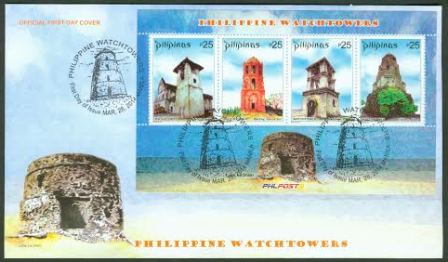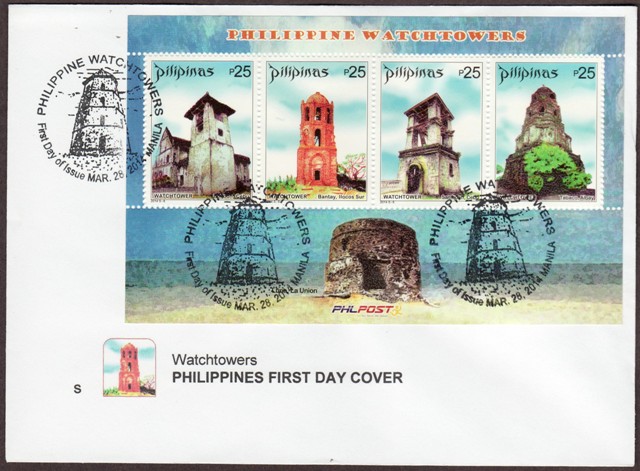2014, March 28. Watchtowers of the Philippines
Litho Offset, Amstar Company, Inc., Perf. 14
Se-tenant Blocks of Four, Miniature Sheets of 8; Souvenir Sheets of 4

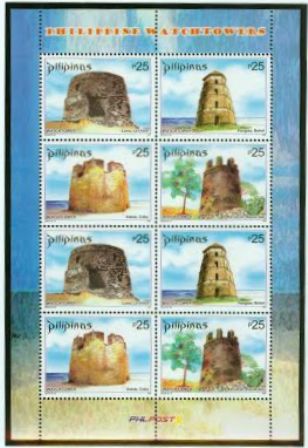
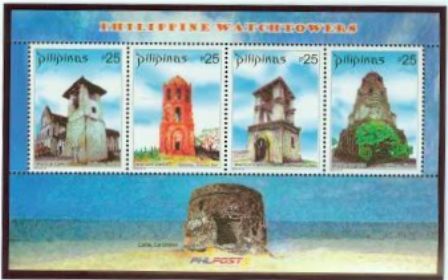
Se-tenant Blocks of For (22,500)
25p Luna, La Union
25p Panglao, Bohol
25p Oslob, Cebu
25p Narvacan, Ilocos Sur
Miniature Sheets of Eight (2 Se-tenant B/4) (11,200)
100p Souvenir Sheets of Four (5,000)
25p Boljoon, Cebu
25p Bantay, Ilocos Sur
25p Sambuan, Cebu
25p Tabaco, Albay
Layout Artist : Victorino Z. Serevo
First Day Covers: Manila
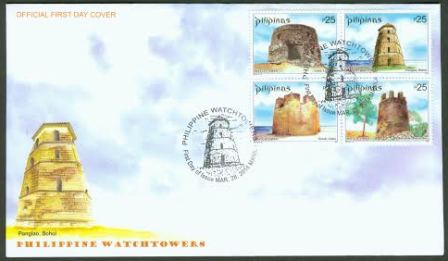
Phlpost Official FDC Envelopes
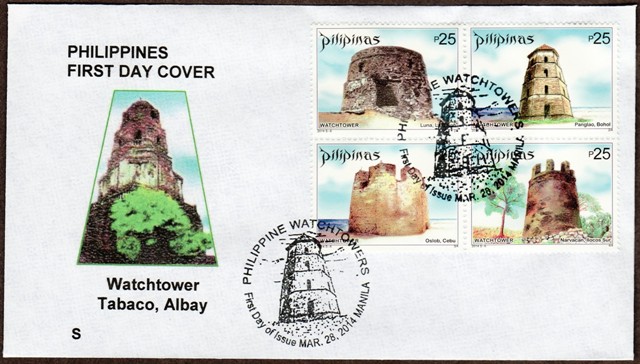
Privately Issued FDCs
WATCHTOWERS OF THE PHILIPPINES
Built over a period of three centuries, to contain various enemies (Chinese, Dutch, English and raiders) the defence net consisted of garrisoned forts, manned by a professional army and sustained by funds from the crown and community fortifications, consisting of watchtowers, fortress churches, fortified towns, small forts and signal towers manned by a militia drawn from the community and funded by community contributions. These fortifications were complemented by barangayanes (armed native vessels) which in the mid-19th century were replaced by steamboats which acted as blockade along raiding routes. While acted clear lines of defence can be traced along the Visayan, Mindanao and Palawan coastline, for instance the choke point formed by the forts at Calamianes and Iloilo, the gateway to Sulu Sea, these points were not always well armed nor fully operational.
Luna, La Union - A deep groove around the inner rim and quadrilateral notches suggest that the tower was roofed. Circular brick watchtower, in fair condition.
Panglao,Bohol - Rising to four and a half stories, the watchtower in Panglao Island, Bohol, is reputedly the tallest coastal tower in the Philippines. The tapering octagonal structure of cut limestone stands behind the ruins of an old Baroque church, probably built by the Jesuits.
Oslob, Cebu - Moving south from Caceres on encounters another of Fray Julian’s handiwork, the octagonal watchtower of Oslob. Its rubble walls on which are propped susod, a sieve net for catching bangus fry and other small fishes, appears solid and in good condition. The fact is half the tower has collapsed in the sea.
Narvacan, Ilocos Sur - The most photographed watchtower in the Ilocos, the tower at Sulvec, near Narvacan, has the silouhette of a rook. This brick and limestone tower is approximately 6.5 meters in diameter and 7.0 meters in height, smaller than most Ilocos towers.
Boljoon,Cebu - Augustinian, late 1700s, Julian Bermejo OSA, church complex within fort, quadrilateral masonry watch tower and blockhouse, some walls remain, blockhouse used as bell tower, in good condition.Fray Julian Bermejo’s defensive structures at close range. Separated from the church by a narrow corridor, the unadorned bell tower of Boljoon, Cebu looks out to the sea. From this tower (from anywhere in the compound for that matter) can seen a watchtower high on the flanking mountain. This was central relay station from which signals using flags could warn communities of imminent danger.
Bantay, Ilocos Sur - 1790, watchtower, no remains of a stone watchtower in the market, but a stone watchtower at Barrio Kuta is reported as being demolished due to road expansion. The name means guard or watchman, in many Philippine languages. Bantay town in Ilocos Sur stands besides the Abra River which flows from the Cordillera to the Luzon Sea. Through this waterway commerce between mountain and sea was facilitated. It was also convenient passage for marauding bands.Three arched windows of Fuerza de San Vicente, built in 1796, overlook the Cebu Strait between Bohol and Cebu. Serving both an ecclesiastical as well as military function, the bell tower has a panoramic view of the Abra River and the towns of San Vicente and Vigan.
Samboan, Cebu - Facing the Tañon Strait and located on a promontory approached by a 157-step stone stairway, popularly called Jacob’s ladder, the watchtower of Samboan is probably the handiwork of Fr. Toribio Gerzon built Jacob’s ladder in 1878. Samboan was under the secular clergy.
Tabaco,Albay - The Tabaco bell tower emblazoned with liturgical and civil bas relieves serves a reminder of Bicol’s once formidable defence based on watchtowers and fortified settlements
-
Tourism
